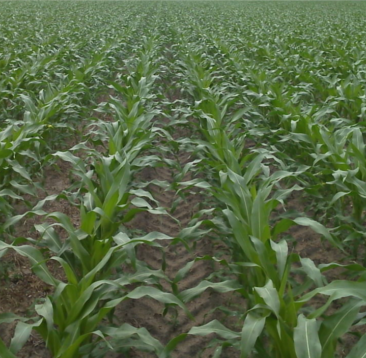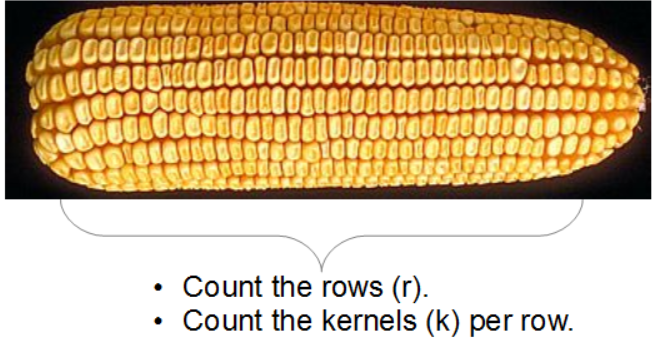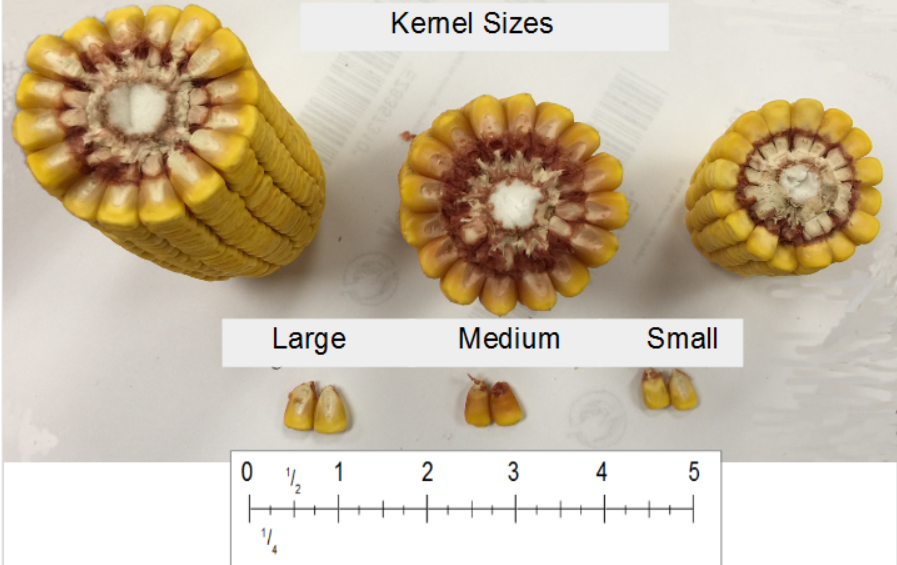Thousandth Acre Row
Tags | |
UUID | 146e6f6e-88c4-11e5-9770-bc764e2038f2 |
The Thousandth of an Acre Row calculator return the length of a row that  Rows of corn equals one thousandth (1/1,000) of an acre based on the width (w) of the row.
Rows of corn equals one thousandth (1/1,000) of an acre based on the width (w) of the row.
INSTRUCTIONS: Choose units and enter the following:
- (W) Width of the rows (distance between planted rows)
Thousandth Acre Row Length (1/1000th): The calculator returns the length of one row that will represent 1/1,000th of an acre.
Corn Yield
The thousandth of an acre is a common area used for sampling the yield of a field. For corn, the thousands acre will be used to count ears of corn in the part of a row equaling 1/1000 of an acre. This provides a decent sample that indicative to the yield of the rest of the field.
The Corn (Maize) Yield Estimation Calculator estimates the yield of corn on any size of land. The calculator includes step by step instructions (below) and calculator buttons (on the right) and embedded calculators in the instruction text. For an instructional video on how to use this calculator by Instructor Lantz, CLICK HERE.
Estimating Corn Yield and Crop Value:
- Compute the 1,000th of an acre row size for a sample
- Count the Ears in sample row
- Compute the average number of kernels of five ears from the sample row
- Compute the Corn Moisture Correction factor
- Assess the nominal Kernel Size
- Compute the Corn Yield in your field
- Compute the Market Value of Corn
No. 2 Shelled Corn Price Survey
The US Corn Price Survey table is an informal survey of the market value of No. 2 Shelled Corn. The US Corn Price Survey information is as follows:
- Date: 7/17/24
- State: PA
- Region: New Holland`
- Corn Price (low): $4.08 USD/bu
- Corn Price (high): $4.48 USD/bu
Step by Step Details
Step One - Sample Row
The most common method for yield estimation relies on taking a good sample of the ears and kernels from one small section of your field, typically 1/1000th of an acre. We'll help you get the right size (length of a row of corn), but you need to be smart and make sure that the row is comparable to the other rows in your field. You know the things that can affect your corn. Pick a row where the conditions are average, not on an edge of your field where sunlight might be different, or at low spot where water may be different, nor a spot that's more or less rocky than the rest of the field. You get the idea. Method to count the kernels in an ear of corn.
Method to count the kernels in an ear of corn.
The first step is to compute the length of one row for the sample. All you need for this is the measurement of the distance between the rows. With that measurement, we'll tell you how long the portion of the row will need to be to create an observation of a 1/1000th of an acre.
So, measure the distance between your Rows, and this step (calculator) will tell you the length of the row of corn to use for your sample. Once you know that length, mark the beginning and end of your Row Section. This is where you'll take your sample. Now, go out through your Row Section, and count the number of ears of corn that you believe will be harvest-able and write down that number. We call it the Ear Count. You know your combine, so you should be able to judge which ears your combine will retrieve.
Step Three - Five Ear Sample Averaging
Now on your way back through your Row Section, pick five (5) average looking harvestable ears. These shouldn't be overly small or old ears unless that's the true nature of your corn. Take those five ears and count the harvestable kernels. The harvestable kernels are those that your combine will take off the cob, not on the tips (pinched ends). For each ear, count the number of rows and kernels-per-row and enter those numbers separated by commas in this calculator. It will provide the average number of kernels per ear (KPE) base on this sample. If you want to compute the average of more or fewer than five ears, CLICK HERE.
Write that number (KPE) down. At this point, we could multiply the your KPE by the number of ears in your row (Ear Count), multiply that by 1,000, and then multiply that by the number of acres you have planted and you would have a good estimate of the number of kernels of corn your land will produce. But there are a few more factors that will affect the volume (bushels) of corn, your estimated yield. These factors are moisture content and kernel size.
Step Four - Corn Moisture Correction
The volume of your corn will vary based on the moisture content. As it dries, it will shrink which affects the total volume in bushels taken to the market. A typical, market ready, 56lb bushel of corn will have a 15.5% moisture content. Depending on the current moisture content of your corn, the volume and weight will be reduced in the final yield. To account for this, measure the moisture percent of your corn. There are moisture testers (e.g. Delmhorst or Koster) to do this, or you can measure moisture content using a good scale and a microwave (See detailed instructions HERE). Once you know your percent of moisture, compute the Corn Moisture Correction Factor:
Step four, calculate and write down your Corn Moisture Correction =100%−Wet%100%−Dry%.
Example: assuming the moisture is 30%, Corn Moisture Correction = (100-30)/(100-15.5) = 70/84.5 = .828.
If you DO NOT know the % moisture of your corn, a default factor of .89 is provided in the next step. Your estimate will be better if you DO measure the moisture and compute the factor, but .89 isn't bad in a normal growing year, not too wet and not too dry.
Step Five - Kernel Size
You're almost done. So far, you've calculated the following:
- Ear Count - This is the number of ears of corn in your 1/1000th acre sample Row Section
- KPE - This is the average number of kernels per ear in your sample
- CMC - The corn moisture correction factor.
The last thing you need is the kernel size and acreage planted (A). The size of your kernels will affect the yield estimation. The number of kernels per bushel can range from 120,000 kernel per bushel for small kernels to only 80,000 kernels per bushel for large kernels. Use the guide (picture) to estimate the size category of your kernels (Small, Medium, Large).
Step Six - Corn Crop Yield Estimate
With the numbers you've computed, you can compute your Estimated Corn Yield. Enter the following:
- Ears of corn in the 1000th acre sample
- Average Kernels per Ear from the five ear sample
- Choose an approximate size of your kernels
- Enter a moisture correction factor
- Enter the acres you have planted in corn
The calculator will return the approximate number of bushels of dried corn you can expect.
Step Seven - Market Value of Corn
Once you have the estimate on the amount of corn your field will yield, you can enter that total volume into the Price of Corn function with a dollar per bushel value to compute the total market value of your corn crop. The USDA predicts a market value of $3.35 per bushel for corn in the United states for 2018.
Ag Science: Estimating your yield of corn grain
Well before harvest, it's possible to estimate the yield of corn you'll realize in grain from your fields. This web page does two things. First it contains step by step instructions, and second it will actually do the math for you via embedded calculators. You will see those calculators at the right time in the instructions and they will pop-up when you click on the right words, usually in bold like these e.g. Kitchen Units Conversion. Enter your numbers, and let the calculators do your math.
The general concept of estimating Corn Yield is pretty easy, and this page really helps with the math. First you will take a measured sample of your corn. The sample will match an area of your field that will then be used to estimate the entire field. In the process, we'll use some science (moisture correction), some statistics (averages of samples) and good old fashioned geometry to turn the observation of 1/1000th of an acre into an estimate for your entire field. But don't worry about the math. We're here to help you with that part. You'll only have to do the instructions and enter your numbers. We'll do the calculating and give you your yield estimate. Let's get started.
Special Thanks to the Expert(s)
The above formulas and step by step process is based on information provided by Mr. Lantz (University of Maryland Extension Instructor) who provided the methods, tested the results and provided final review of this page. Information was harvested (pun intended) from his own experience and resources. For supporting information, consider the following:
- https://www.agry.purdue.edu/ext/corn/news/timeless/yldestmethod.html
- https://extension.umd.edu/sites/default/files/_images/programs/anmp/NM-4.pdf
- YouTube Instructions on Corn Yield: https://youtu.be/_d5-JvuQNYM
Recent Corn Yield Data from the USDA
A farmer can compute a good estimation of corn yield while the corn is still standing based on a 1000th acre row survey of their own field using their own acreage and a moisture correction factor. The Corn Yield Estimation Calc walks through the process. In the absence of a personal estimate, the U.S. Department of Agriculture provides statistics by state and year. Note, current weather conditions greatly affect corn yield.
In the U.S. Department of Agriculture Crop Production 2020 Summary report, the following information on Yield per Acre
Grain Calculators:
- Corn Yield Estimation Calculator - Estimate the size of corn harvest (number of bushels) while the crop is still in the field based on a sample, acres planted and quality factors (kernel size and moisture).
- Crop Value Estimation - Estimate the value of a crop based on the acres planted, yield per acre and dollar per bushel.
- Corn Products - Estimates the amount of derivative products that can be produced based on a volume (number of bushels) of corn including: pounds of beef, pork and poultry, corn oil and ethanol.
- US Corn Pricing Survey - Regular survey of market prices of corn
- Grain Crop Weight Estimation - Estimate the weight of a grain harvest based on the number of bushels and pounds per bushel of the grain.
- Grain Crop Value Estimation - Estimate the value of a grain crop based on the acres planted, yield per acre and dollar per bushel.
- US Corn Pricing Survey - Regular survey of market prices of corn
- US Wheat Price Survey - Regular survey of market prices of wheat
- US Soybean Price Survey - Regular survey of market prices of soybean
- Quantity Required for Moisture Blending - Computes the amount of grain needed of one moisture level to mix with another to achieve a desired moisture level.
Collections
- Comments
- Attachments
- Stats
No comments |
